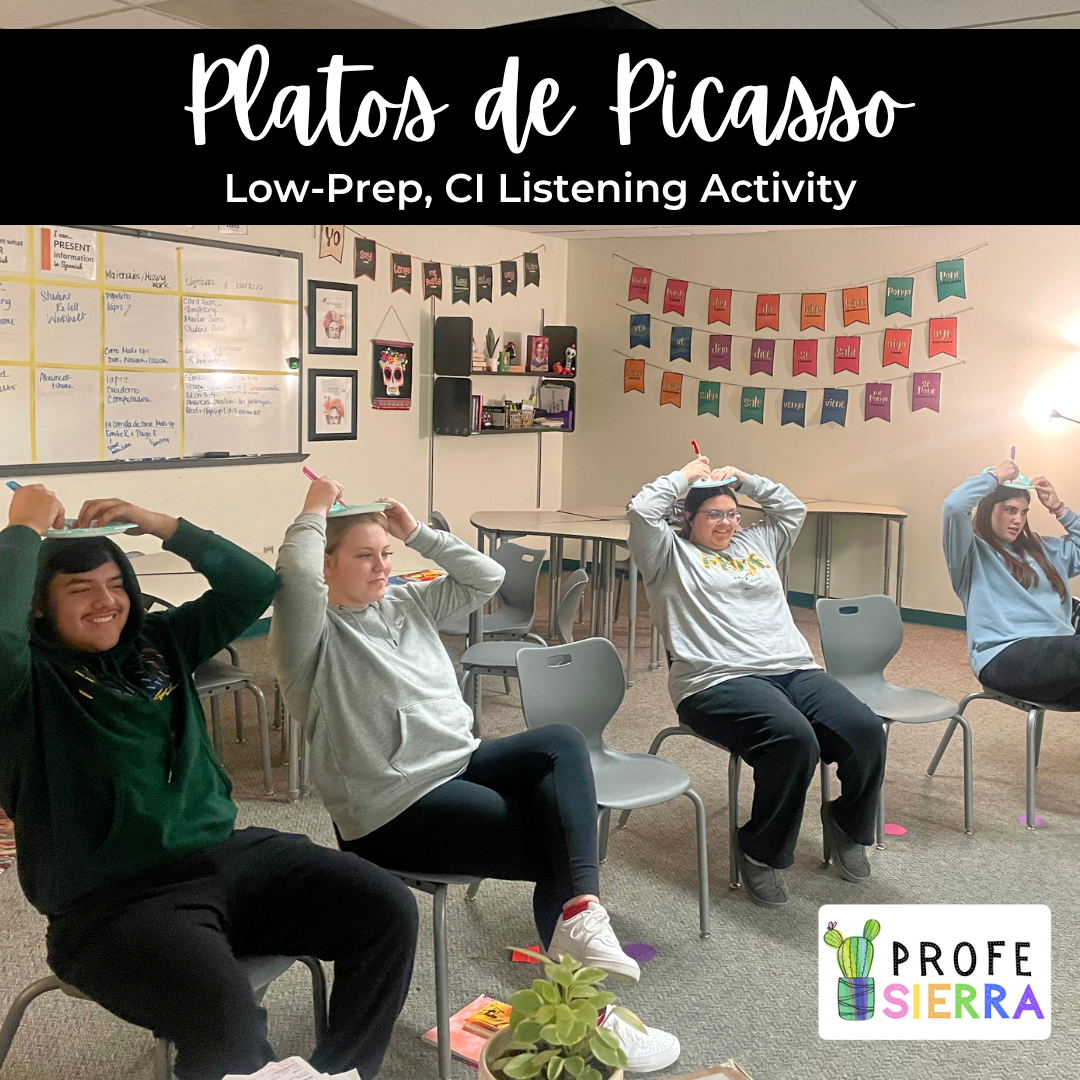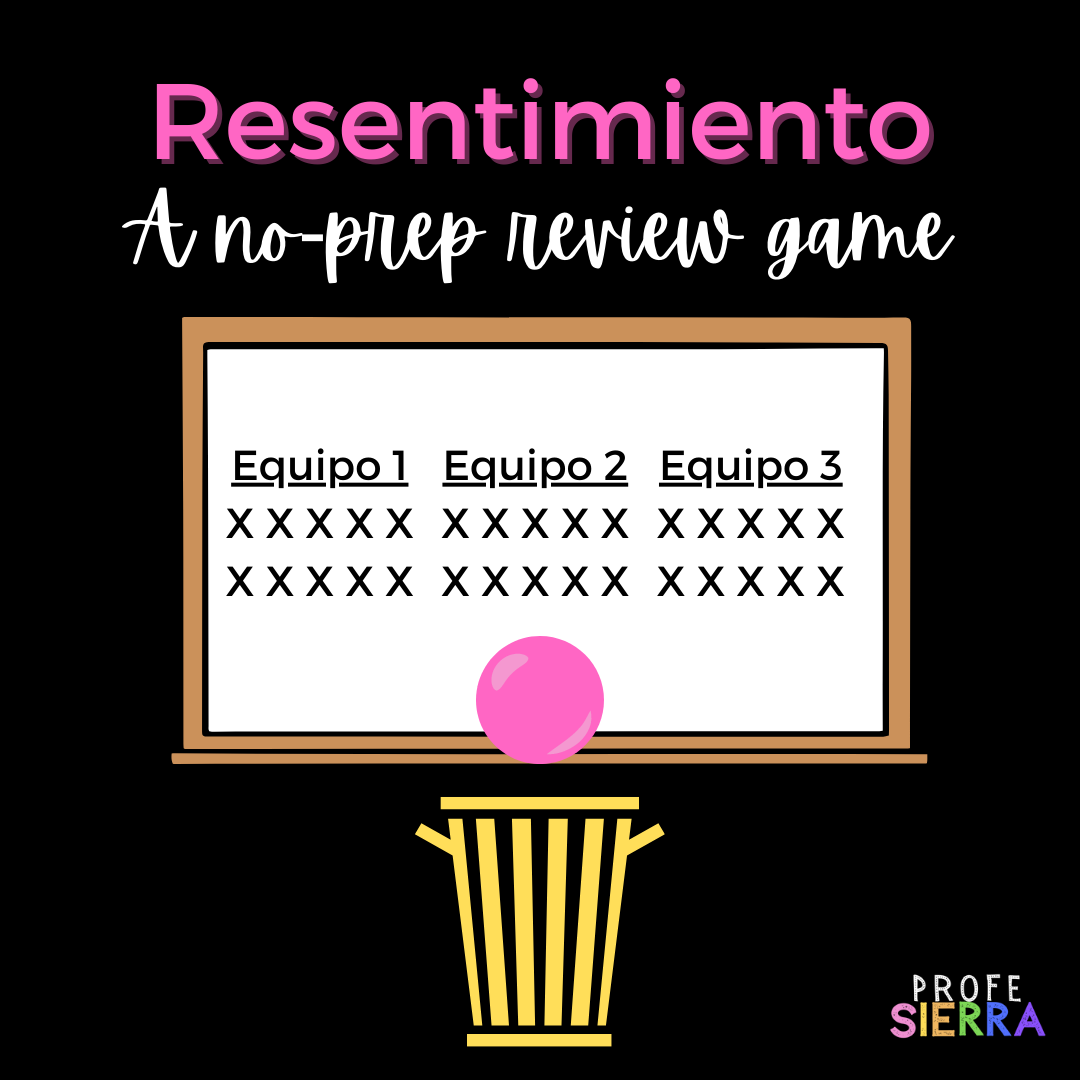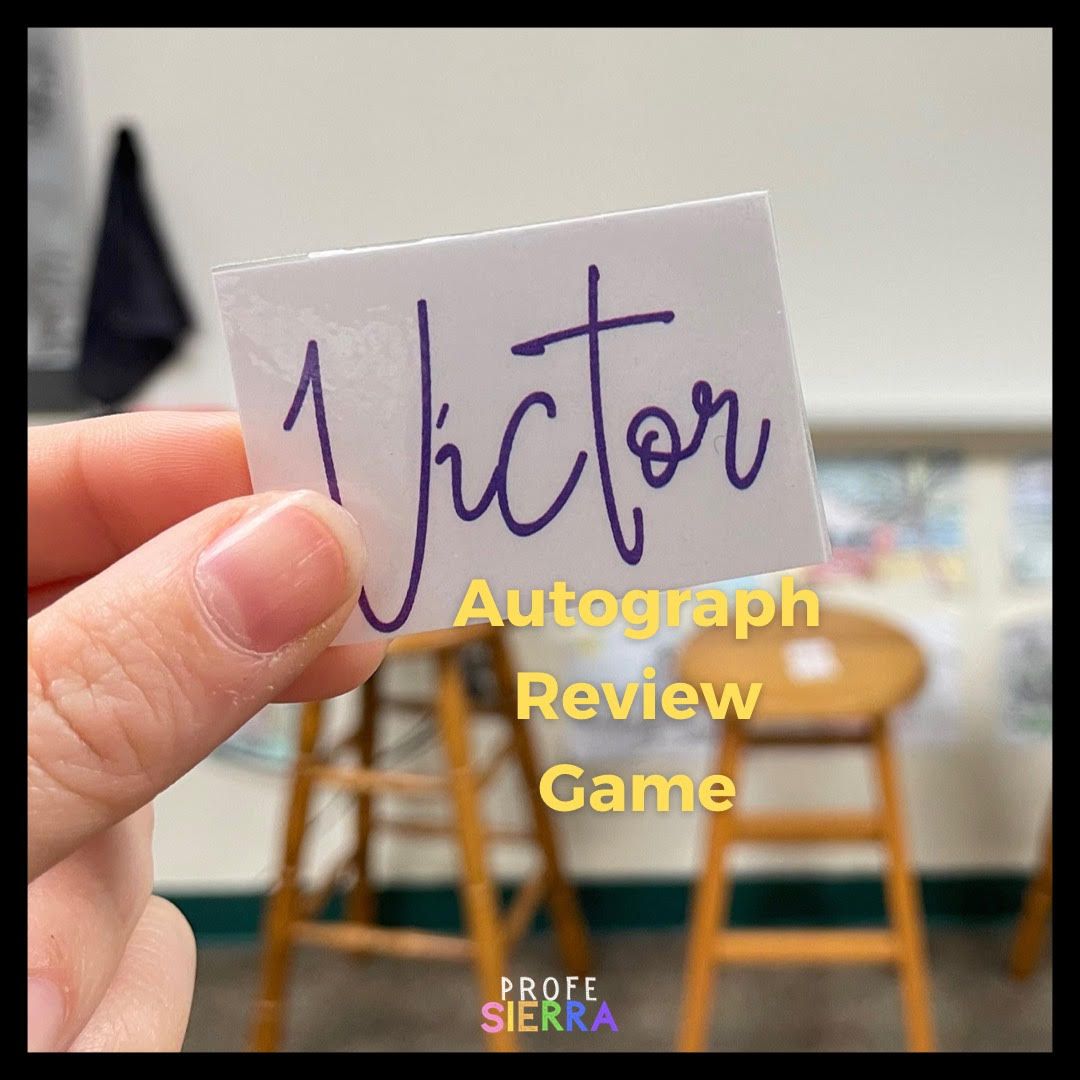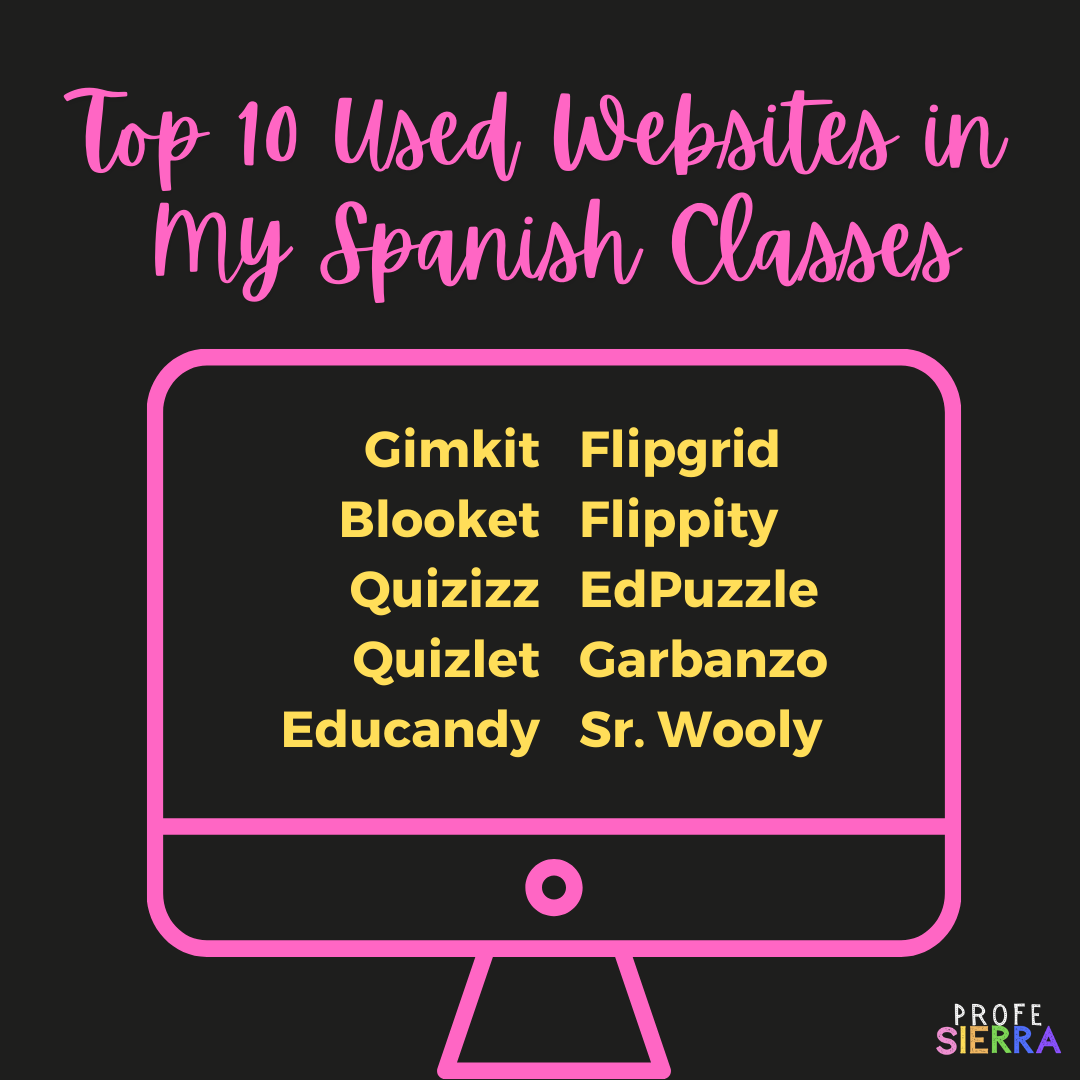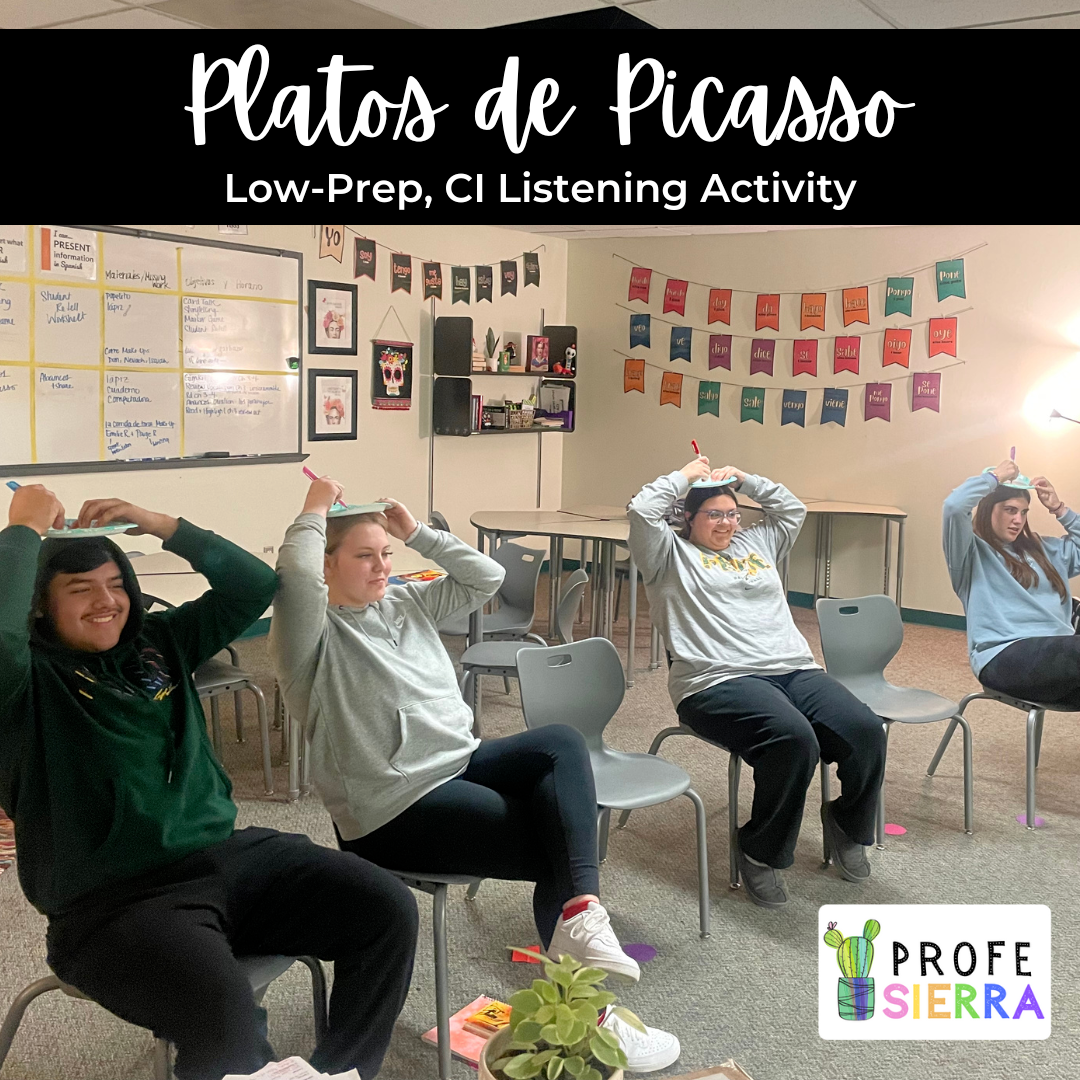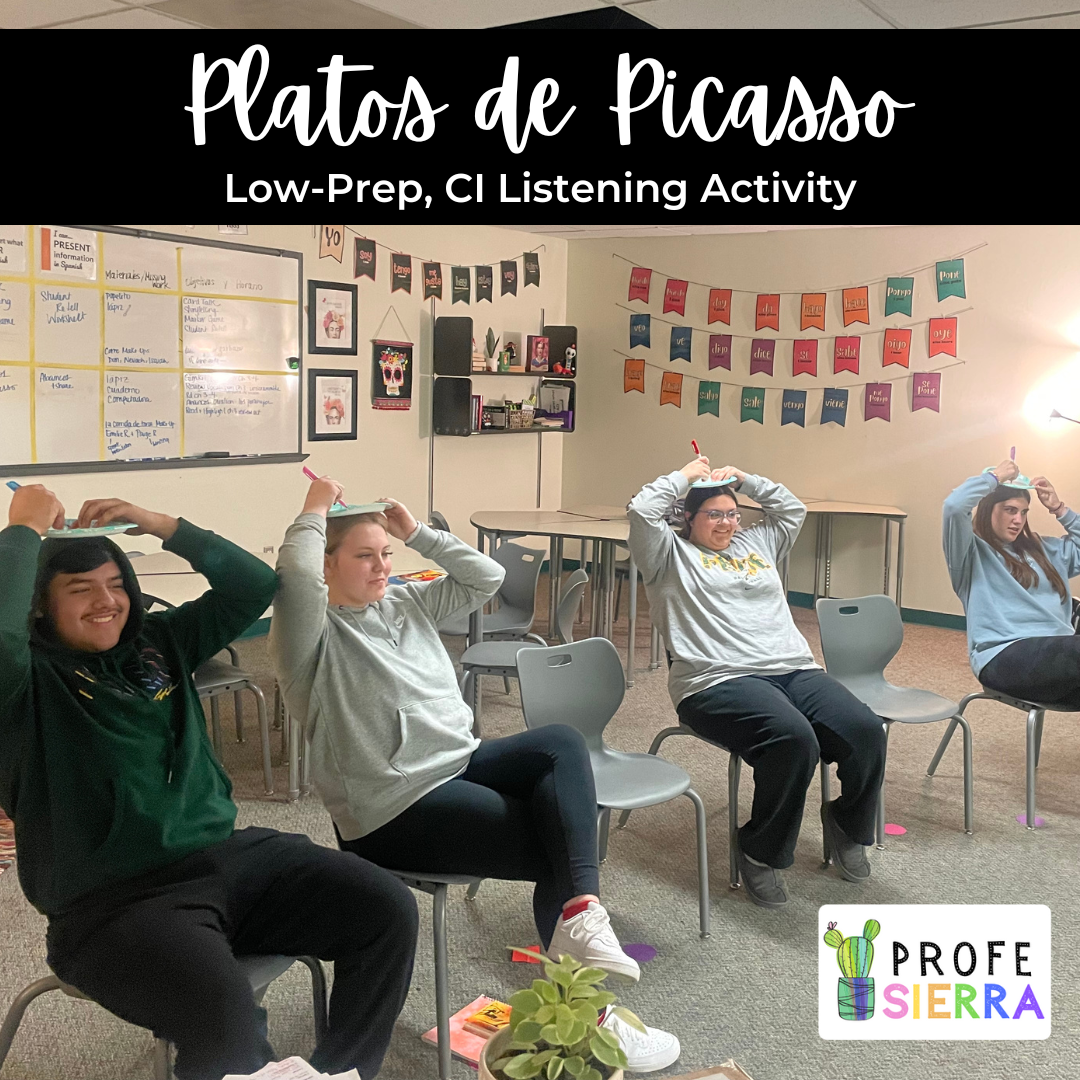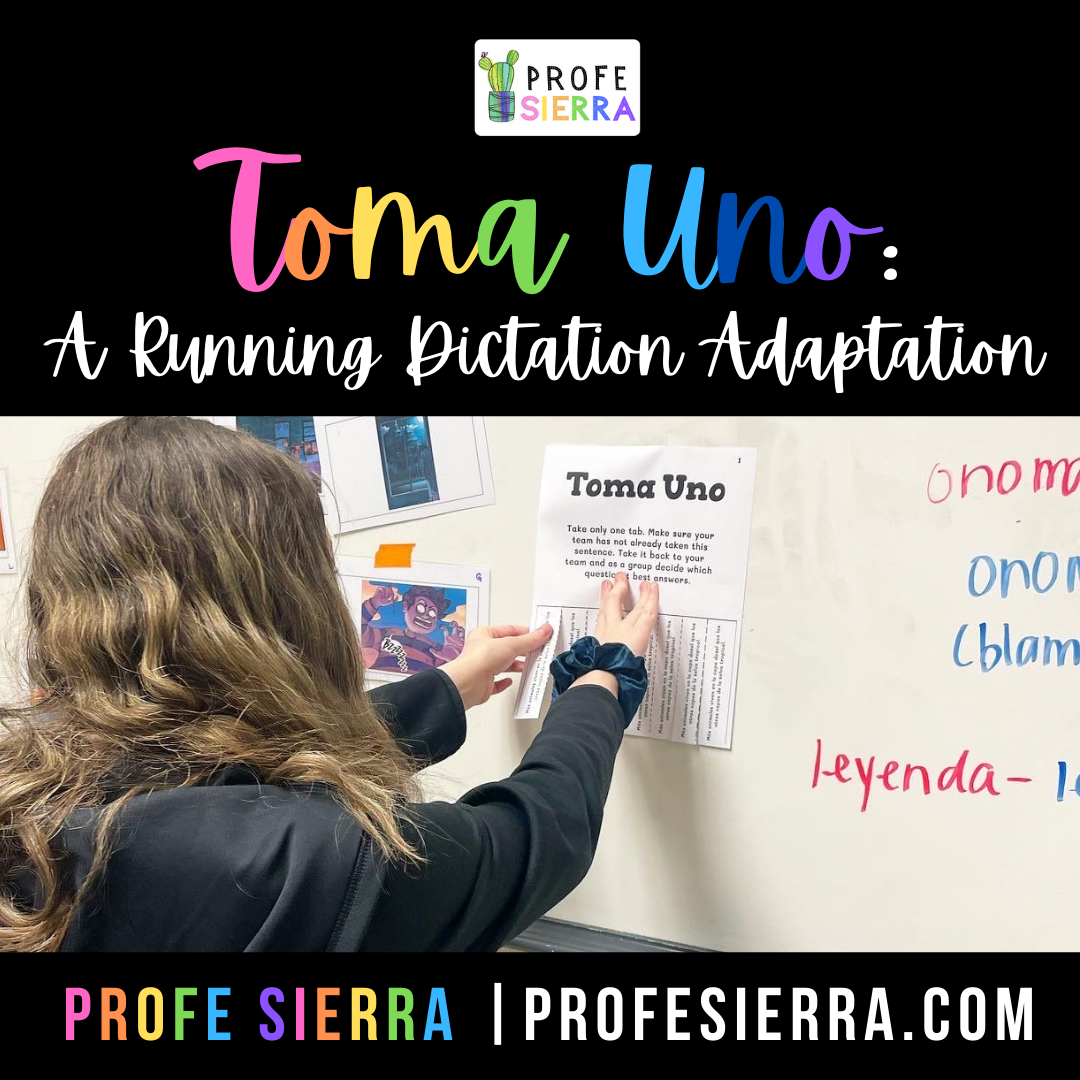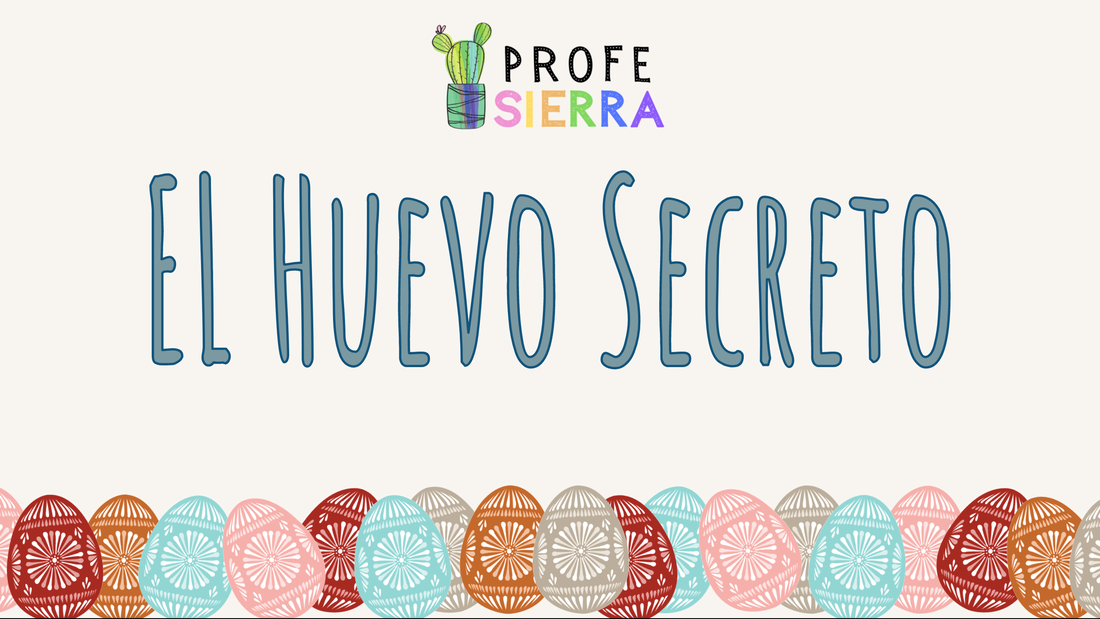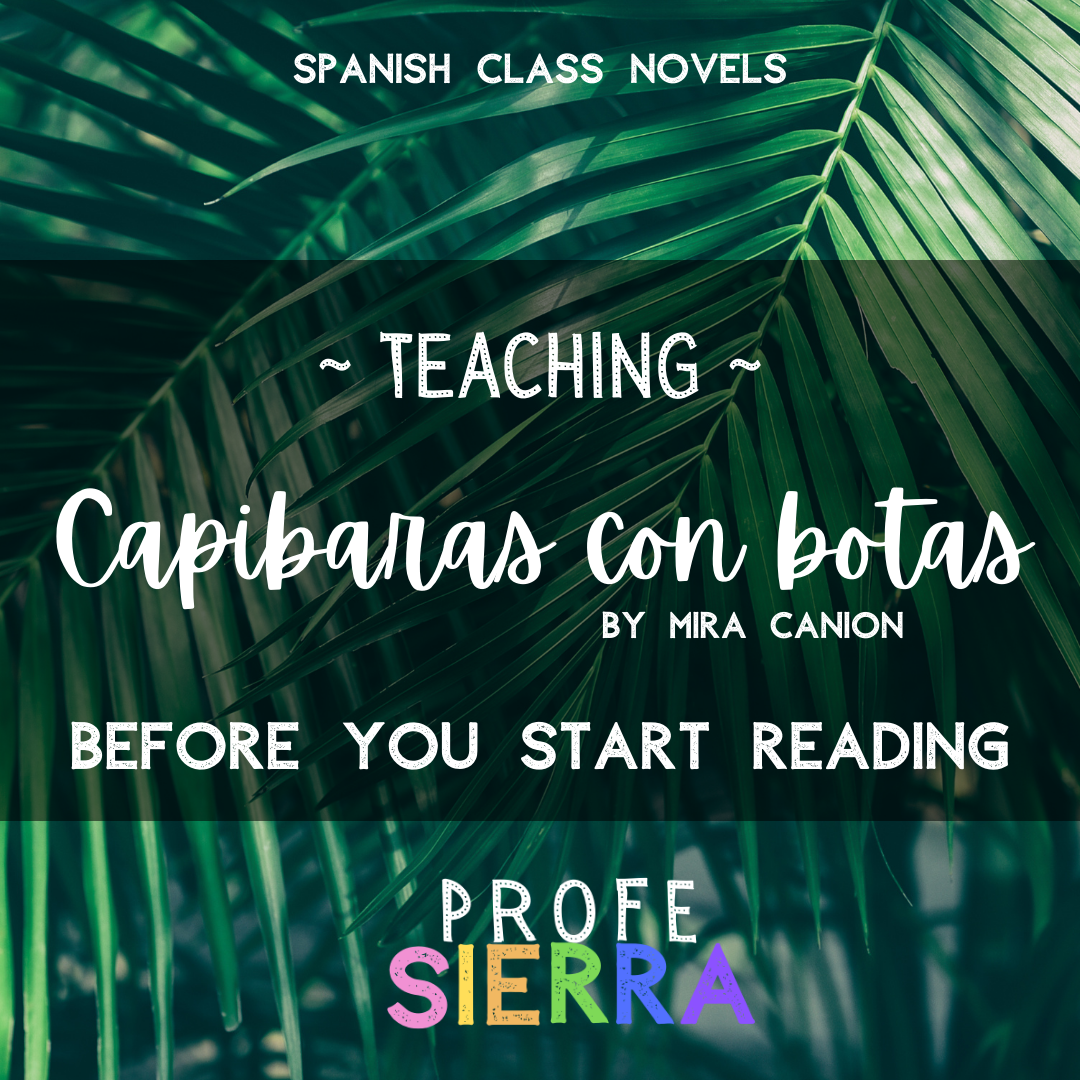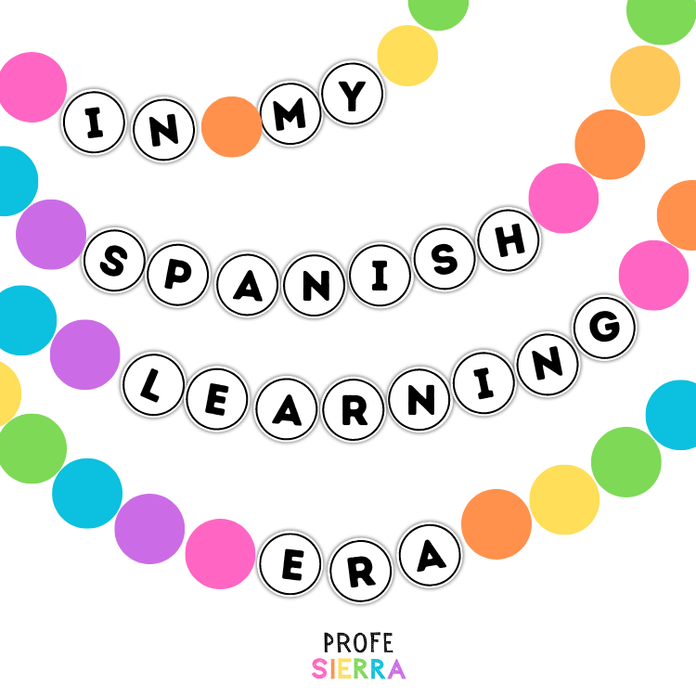 Inside: New, trendy classroom decor and materials to share with students. Anyone else a fellow Swifitie?! NO? That's okay, (but you're seriously missing out!) Many of you are probably aware of how popular Taylor Swift has become this summer with her re-releasing her albums and her tour and if you weren't just google it! At her concerts fans have started trading friendship bracelets and that's where I took the idea for the bulletin or door decor from. On top of that, there is a common phrase of being in your "_____ era" (Boy Mom Era, Teacher Era, etc.) because of Taylor Swift which is where the Spanish Learning Era comes from and I think it will be a big hit with students. I thought it was a fun way to spark conversation about how students can take their own Spanish learning outside of the classroom, so to help you all out I have compiled some lists to help you all! Grab the resource to display these ideas with students as a bulletin board or door decor --> HERE! 1) Listen to Spanish music. Here are some playlists I recommend! Canciones para la clase, Alvaro Soler, Morat, Cleaning Kit en español, Camilo 2) Read Spanish novels or comics. Comics en español, Wayside Publishing Comprehensible Novels -- if you have a classroom library and you already do free voluntary reading that's a great way to start and if a student is interested in reading more outside of class don't stop them! I've found that Spanish versions of popular graphic novels like Heart Stopper and Nimona are super popular. 3)Watch Spanish television or movies. Netflix: Go! Vive a tu manera, Siempre bruja, Maya en los tres, Disney+: Tierra Incognita, Viaje al centro de la Tierra, Mexico: Nailed It! 4) Create a Duolingo account. No, I don't think Duolingo is an actual way to learn a language without other comprehensible input and means to acquire language naturally, but it is an easy support that can help with spelling and vocabulary acquisition. I also find that students become naturally competative when placed in classes and can see where they stand as a class. In my humble opinion any Spanish interaction outside of the classroom is good and can't hurt. 5) Listening to podcasts in Spanish. If you don't already use these in your classroom I highly recommend using them! These are best suited for students at a Novice High or Intermediate level unless they have additional support. Duolingo Podcasts, The Unlimited Spanish, Cuéntame Podcast, Un Día en español Hopefully having these resources in your toolbox can help you give sound recommendations to students as they continue their Spanish learning journeys.
0 Comments
I was first introduced to the Plate Sketch Game by Cynthia Hintz 5 years ago when I was student teaching with Allison Wienhold (Mis Clases Locas) and recently I was re-reminded of how fun and engaging , but also input heavy this activity is thanks to the teacher's guide for Bianca Nieves y los 7 Toritos by Carrie Toth (Somewhere to Share). We had a great time using this activity with the novel -- one of my favorite teacher's guides of all time.
Materials: Cheap paper plates Sharpies A script of what to say! How to play: 1) Pass out one paper plate and one sharpie to each student. 2) Instruct students to put the plate on top of their head and that they will draw what their teacher describes WITHOUT talking. Spanish example: "Pónganse el plato encima de la cabeza. Clase, mientras yo describo, quiero que Uds. ¡dibujen! Dibujen lo que describo pero ¡no lo vean!" 3) Then slowly say your script "In the center their is a boy" and add on to it. "In his right hand he was an apple" "Behind him their is a house" "The house as 4 windows and a door" etc. 4)At the end compare their works of art and continue to circle "Does Dan have the boy in the middle?" "How many windows are on the house in Hailey's artwork?" etc. 5) Finally, you can award points for each thing in the right place or vote as a class for the best overall/most accurate or clear. 6) Finally, have fun and be ready for lots of laughs! Holiday ready-to-go, themed options: El Día de San Valentín - by Profe Sierra Check out Mis Clases Locas blog for a Navidad themed version And if anyone else makes a version wants to share please email me at [email protected] I'll add it to the list to share with everyone! Resentimiento, also known as Trash Ball or Grudge Ball, is a review game I remember playing back when I was in high school (specifically in math class of all places) and I've seen it pop-up various times in different teacher's guides and curriculum throughout my time teaching, so I thought I would type up my own blog to reference about this classic game. It's often in rotation for me as it requires so little prep, but is extremely engaging and gets students moving. I did not invent this game, honestly who knows who did, but you can also read about it on this blog from Martina Bex if you would like to see it explained somewhere else-- she also explains really well how to introduce and set up this game so there are no hard feelings from students (believe me there can be it's very competitive.)
This game is for me-- a no-prep game which is a reason I love it. Here's what you need to do! Prep: You need a list of questions /tasks to ask your students. You can predetermine these, pull them from the top of you head as you go, put them on a slideshow they can be fill in the blank, true/false, open ended it's totally up to you. Set Up: -You need a bucket , bin, or trash can for students to aim at -a ball for them to shoot with. I use a small soft one from Amazon -tape or place rulers on the group to indicate the two locations students can shoot from one pretty far away from the basket and one about halfway to it -Place your class into teams this works best if you have at least 3-4 teams but I have done up to 6 depending on the size of my class -Have each team come up with a Spanish team name and then write them on the board. Below each team name draw 10 Xs. Start the Game: - I arbitrarily choose a team to start . I tell them the game is going to make them resent people and have grudges so they might as well start with me. :) -I ask the first team a question. * If they answer correctly: A team member will get the ball and decide which line to shoot from. If they miss they get to erase 2 Xs from any other team (you can never do anything to your own teams Xs only other teams) If they shot from the line closer to the basket they get to erase 4 Xs and if they make it from the back they can erase 5 Xs. *If they answer incorrectly: That team must add 2 Xs to the board, again they can't give them to their own team they must give them to other teams. -When taking or adding Xs a team can decide to divey them up however they want. That might 4 to one team or 2 to one and 2 to another or each gets 1 taken away. You can end the game after so much time or if you have a certain list of questions you want to answer or 2 min before the bell rings it's up to you and your student's engagement. The winning team is whoever has the most Xs at the end of the game and even if a team's Xs are all gone they can come back when other teams miss a question and have to add Xs to the board. Hope you and your students have a great time reviewing and creating memories! 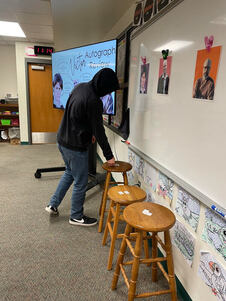 Reviewing content before a mastery check or assessment is a great chance to gamify your classroom and still get in lots of student-to-student collaboration and repetitions of key structures or vocabulary for a unit. This blog isn't going to dive into how I teach using Sr. Wooly, but instead just one activity that I did. I traditionally teach Guapo, Confesión de Víctor, and Feo as a trilogy over a week or two in Spanish I. I like the story, vocab, and ability to work in that description, clothing, and other classic vocabulary sets since I don't teach a traditional curriculum. I think it makes it more authentic and engaging for sure! I think this game can be easily adapted to any content or topic with a little creative thinking. I like that it ties in random/luck like The Unfair Game, The Lucky Reading Game, Grudge Ball or Decisiones which are all review games we love here in my classroom. What you need: -A common topic students are familiar with and have been working with! -Task cards - simple tasks that require students to show mastery or practice using information covered in class (Translate, Write, Draw, Fill -in -the-blank,Write a question, etc.) -Posters or drawings on the board you can assign or hid random points behind. For my Víctor review it was different headshots of Víctor from throughout the story. -A way to indicate that a team has chosen a poster (a piece of paper, writing initials on the board, dragging and dropping an image if you have an interactive board) I used 'Víctor's signature' so he was effectively singing the headshot as a way to keep it all on theme. All of my materials for this Victor version are linked at the end! How to Play: 1) Place your students into groups of 3-4 students 2) Set a timer for how long you want to play (30ish min is good! But less can work , too) 3) One student comes up and gets a task card and takes it back to their group. You can see my Víctor Trilogy ones HERE. (I cut them apart and printed them on different colored paper for each group for my own organizational needs) 4) When a group thinks they have the answer they bring the task card up and if it's right they get a signiture to place on the headshot they want to. If it wasn't write give them a hint or point out whats wrong and send them back to fix it. 5) They keep going repeating steps 3-4 until the timer runs out. 6) They you flip over the posters to reveal how many points each was worth. Multiply it's worth by how many signatures each group they assigned to each specific poster. Watch a video explanation HERE! For example: If Equipo Morado had 5 signatures under the poster worth 5 points, 6 under the one worth -20 , and 7 under the poster worth 50 points. So that team would have 655. (But I also make my students do the math in Spanish to review numbers and because they are better mathematicians than I am). You can make them worth 5, 10, -5 . It really doesn't matter. It's all random. I would recommend changing it from one class to the other or they'll tell each other which ones to pick! That's why I write on the back of my laminated posters each class with random point amounts. Here are my slides for the Víctor Autograph Review if you happen to also teach these or want to see what it looks like as well as the posters and signatures. I'd love to hear how you adapt this game to other topics! Technology is a beautiful thing, when it works, right??... Well hopefully it usually works for you and you can use some of these sites , games, and ideas to enhance your lessons and make your lives easier!
I am always looking for websites and other fun things to make class more engaging OR my life easier, so with no further ado and in no particular order here are 10 websites I use often in my classroom and some of the ways that I use them! Gimkit Gimkit is a student favorite, especially with all the new and different game modes coming out. Students answer multiple choice questions, listen and click an answer, or type in an answer in order to gain money or energy to complete different game mode tasks. My students love the fishing mode, draw it mode (think Pictionary-- it's awesome) and tag. mode This is a paid subscription , but my district does pay for it. The reason they pay for it and the real reason I love it is that with the paid subscription I can get data on my students. After they finish playing I get a student-by -student write up that shows how many questions they answered, words they missed, words they never missed, etc. I love assigning Gimkits as we read novels so I know what vocabulary we need to focus on or target during that unit. I also like that Gimkit has a HW option like Blooket where you can assign practice or review to students to do on their own. And as you will hear with many of these, I love that other teachers have created lots of sets for almost any curriculum or novel and I don't have to recreate the wheel. Blooket A student favorite no matter the level. I like that the modes are engaging and as new ones come out my students get excited to review or introduce content using the interactive fun modes. I like to use the traditional, kahoot-esque modes for reviewing content as a class. I also like this mode for assigning homework , review materials, or extension activity options. There are so many sets available on this website as well. I've rarely had to make new ones. *GAMEIFY BLOOKET AND GIMKIT* with Musical Chair on Gimkit/Blooket Not that Blooket and Gimkit aren't already fun , engaging, games, but let's take it to the next level and make it a movement-based game. As students play I randomly yell Levántate and students have to stand up and walk around the room. When I yell Siéntate they have to sit down and begin playing at the computer closest to them. The goal is to be at the winning computer when the timer runs out. You will have to set expectations of sitting down where they are closest and not purposefully sabotaging computers etc. You can have everyone put in a code name in Spanish instead of their real names so that kids don't look for certain computers. Quizziz This website has assessment, instruction, and practice (HW) options . I like assigning them as HW as a comprehension check for students. It will give the m a percentage and clearly let them know if they should move on. It's fun to do a class/group one at the end of the unit or before summative assessments because it will break down questions by which was hardest, etc. It also gives a class percentage so you can see how proficient your students are. It still has a game aspect just not various modes like Blooket and Gimkit. There are lots of assessments created by other teachers on there as well. I do not pay for a subscription by any means I just use what is free or create what I need. I like them for reading standard checks. Quizlet Quizlet is like the ancestor of Blooket and Gimkit. In many ways Quizlet walked, so some of these other sites could run... that being said it probably has the most sets available over the widest range of topics and curriculums. It's also a great option for students that want flashcards or something like that. I post links or provide them often so students can review before retakes. *LEVEL UP* with Quizlet Live Relay Race This is a student favorite every year and you can read how to do Quizlet Live Relay Races from Mis Clases Locas. Seriously, your students will love it and it get's them moving! Educandy Another great option for student individual work time , extension, or intervention. This site takes any set of vocabulary you may have and creates lots of little games for students to play to practice. These games include tic-tac-toe, crosswords, memory, word searches, etc. Not as organized as other sites nor as many sets, but it's pretty easy to make them from Quizlets. However, it can only be played on as an app, so your students would need personal devices OR a classroom iPad as a station is a great way to use it. Flipgrid Flipgrid is a site that allows you the teacher to pose a question verbally or written to your students and they respond with videos. I use these often for speaking assessments, because it's great for students that don't want to talk in front of others as well as it allows me to listen to them speak as many times as I need to in order to give an accurate score. Students can also respond to each other by recording video responses to each other's questions. It's free, it's user friendly, and it's great if you're going to be gone and you still want your students to talk and give them feedback. Flippity Flippity.net is powered by Google and houses a variety of templates from Google Sheets that become things like Jeopardy, Word Searches, Name Wheels, Digital Break-Out Rooms , etc. No more wasting time on formating or creating just punch in your information and let the template do the work. I highly recommend the name wheel which I use often because it makes groups for me, puts students in order for conferencing, and so much more. EdPuzzle This site really blew up during the pandemic, but I still love it for review, extension, and intervention. I also love using it for movie talks , because those aren't my favorite CI activities to do. But basically you can link any YouTube video and insert questions throughout the video that students need to respond to. I use the free version and pre-made videos other teachers have made. I like to use these for listening assessments sometimes , too. Garbanzo This is an education website that is tied to the SOMOS curriculum from the Comprehensible Classroom by Martina Bex. You can read more about it at her blog here. I often use it to intro a new SOMOS unit in Spanish I or as extension as we go through the unit. I like the data it gives me and the repetitions my students get in. They are adding more stories and podcasts and things all the time! Sr.Wooly Sr. Wooly is a video and graphic novel creator and it is AMAZING and so worth every cent. We use curriculum money to buy our subscription. I love that each story has assignments housed on the site and that they come with activities, lessons, and a very collaborative community. It's a great sub plan and you'll gain access to several graphic novels if you're wanting to teach with novels. *BONUS* saying 10 websites has a good ring, but I also use, Duolingo I have all my students create accounts day one and any time they finish fast they know that it is what they are supposed to be working on with free time in my class. They could also choose to free read from our classroom library, but most work on duolingo on their Chormebooks. I also use the podcasts often in my upper classes and will be sharing more on that soon. What sites do you use in your classroom? Am I missing any on this blog? 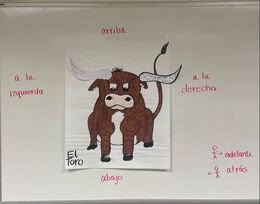 It's important before I begin talking about my bullfighting unit I taught in Spanish III recently that I recognize and thank the amazing creators that shared before me, because without their bravery and consistency in sharing I wouldn't have been spending SOO much time creating things for this unit, so a HUGE thank you to Elizabeth Dentlinger for the materials and mapping of her bullfighting unit, as well as Carrie Toth and Allison Wienhold for sharing on their blogs, so that I didn't loose my mind trying to teach something new. That being said I will be linking things from their blogs as I go! DISCLAIMER: I teach on 90min blocks and I see my students every day, so my lesson/day plans may seem extensive. YOU may need to break up days to make them work in your room or get rid of less "essential" activties. Day 1: I used the KWL idea from Sra. Dentlinger and just made my own so that it said my own name you can edit THIS ONE. I liked this because it gave me a really clear idea of how little my students knew about bullfighting and especially Spain. We watched a short youtube video of Northern Spain (because that's where I lived and went to university) while they filled out the first two sections. They then handed them back into me. Then I used Sra. Dentlinger's PQ+As for bulls and bullfighting. Because I am doing this as our first unit/novel in Spanish III , I just added some more questions that asked students to use a little more language since they had that ability. Then students read this short non-fiction informational reading about Spain and bullfighting (volleyball translation style) with a partner and completed the activities on the back individually. I like incorporating these kinds of readings at the beginning to help set the scene and to just get in more of that kind of reading and language for my students. It's how they learn 'limita' 'frontera' 'notre, este, sur, oeste' etc. For extension/fast finishers: I assigned an EdPuzzle about the geography of Spain. Day Two: I handed back the KWL sheet and had students add anything they learned about Spain and Bullfighting so far to the L section and the re-collected them. I then had students read the Torero Reading from Sra. Dentlinger individually. We went over them as a class. We did this before watching Blood Brother's on Youtube so students understood the different rolls of different toreros. I read about the 60min documentary on Somewhere to Share and looked everywhere for the full documentary everyone talked about being free in their blogs. It's not any more, boo! But I did find this 15min excerpt from Youtube and had students watch and answer these questions as they watched. We then went over the questions as a class. Then my students worked on Sra. Dentlinger's El Traje de Luces worksheet. Day Three: We did a Kindergarten 'Read'/Picture Talk of the book Ferdinando el toro. Kindergarten Read is exactly what it sounds like. I like students grab pillows and folding chairs and the sit on the floor in front of my stool criss-cross-applesauce and I read them a book. This time I used this Youtube video (because I am not a native speaker and I like to get them exposure to as many accents/native speakers as possible) and I paused and would do some circling with the images. I then had students decorate a pair of bull horns in pairs of 2. They could decorate them however they wanted and they put their names on the horns. This is because we then went on to play 'Pin the horns on the bull'. I drew this picture of a bull on a jumbo sticky note pad , but you could easily project a photo of Ferdinand the Bull from the movie, too. Students then had to direct their partner to put their single horn using Spanish directional words. The whole class would yell 'Olé' when they were done and we voted on who got the closest as a pair and they got candy. It was VERY fun. Everyone was super engaged and it was truly one of those connection over curriculum moments or 'memory making' moments. Then students worked individually on this Anatomy of a Bull worksheet. I had to make my own version of Sra. Dentlinger's, because the link to the website her students used doesn't work anymore. SO here's mine. I don't love the website I found to replace her's , but it "worked" fine for this activity. If you find a better version let me know! Day Four: I wrote the bod y parts of the bull on paper and we taped them to the picture of the bull I drew to review/check the worksheet from the day before. I just wrote the one large post it's and we stuck them on. Then we listened to the Duolingo Podcast El torero de hoy and students completed this worksheet as the listened. Day Five: Our final day students came to class prepared to debate for or against bullfighting and we did this fishbowl style. They then wrote a letter tell someone about bullfighting and giving their opinion on the tradition. Here's my assessment . Now we're moving on to reading Bianca Nieves y los 7 toritos by Carrie Toth and I can't wait to share that journey, too! I'm starting a new series where I quickly talk about my go-to, comprehensible input techniques so I can more easily share a 'how to' with people asking for more in-depth explanations then what I provide over on Instagram or Twitter-- make sure you're following me for ideas like this one! (@profe.sierra)
This week we'll be looking at Weekend Talk. I was introduced to this technique by Allison (Mis Clases Locas) when I was student teaching with her. She also has a blog full of ideas here . I've also read about it from Ben Slavic and Martina Bex, so I am by no means the founder or creator of this ingenious idea. It's been around in the 'Comprehensible Input Toolbox' for a lot longer then I've been using it. At its core Weekend Talk or, Weekend Chats as it is sometimes referred, is a more thematic form of Personalized Question and Answer. It's your chance to talk to your students about their lives and what happened over the weekend. I love it for Spanish II and III, because it's a very organic way to get in reps of the past tense, but more then that I love that it is a chance for connection to happen during curriculum and that it requires little to no-prep on my part. I do this most Mondays in my classroom, but I especially love it when there has been a long weekend, an event (like homecoming, prom, etc.) or a holiday. Lowest Prep Versions 1) The OG Way To keep this super simple and the lowest-prep possible you can simply ask students questions: What did you do this weekend? Where did you go? Did you... (go to a football game, play a video games, go out to eat?) ? And anything else that is comprehensible and relevant to ask your students. I like to go in with like 5-7 questions and a list of my students names. I check them off to make sure everyone has shared and then we move on to our normal "as scheduled" activities. 2) Yes or No Give students a list of typed out options for activities they may have completed over the weekend. Have them check yes or no if they did those. Collect them and simply call our info "_____ and _____ went to the football game." , "_____ visited family.", etc. 3) 2 truths and 1 lie -- here's my FREE template I use. Have students write two true statements about their weekend and one lie. They read it out loud and their peers try to guess the lie. 4) Timed Free Write Set a timer. Supply some sentence starters and frames and have students write to you about their weekend. These kinds of comprehensible input techniques are essential, because I think they are the closest many of our students get to organic and natural use of the target language in the sheltered space of a language classroom. Other Ideas: Here are some other options for 'shaking up' Weekend Talks from other Spanish teachers, because I strongly believe in not recreating the wheel! Digital Version Find Someone Who Version Question Cards - for conversation practice OR my FAVORITE post them on the board and have students write initials under what they did and discuss the results as a class. Should I post a blog about having my Spanish 3 students do visual blogs for Weekend Talk? Let me know if you'd want to hear about that, too! Inside: Toma Uno - a fun activity that will get your class moving and engaged no matter what level they are at. This activity is great for anyone that loves doing Running Dictation and is looking for something new. I first learned about it when student teaching with Allison Weinhold | misclaseslocas.com, in 2019 because she sent me this video from Carrie Toth | somewheretoshare.com (she learned of it from Todd Hanlon-Alle) and that's the beauty of sharing on the internet is finding ideas that stay with you throughout the years! Toma Uno is a group collaborative and competitive take on basic comprehension questions. It's also a great way to give students valuable input and model question and answer writing. It also encourages students to use decoding skills to match answers with questions in the target langauge. Carrie does an incredible job of explaining this activity and you can see that in her video below: (If you like to read instructions I've typed them below!) Prep:
Write 10 questions and their corresponding answers Print question papers Print and cut tabs on answer papers Hang answers around room and hall Put students into groups of 3-4 students. Give each group 1 paper with all the questions on it (I recommend 10 questions). Also give them a glue stick. Students rotate one student going to pull an answer tab from one of the pieces of paper hanging around. (Label each answer paper with a number or letter so students can communicate which ones they've already pulled so they don't repeat) That person brings back their answer tab and they work as a group to decide which question it answers/belongs with. You can have them race the other groups to make it competitive. Helpful Tips: -If doing this with more advanced students consider throwing in some FALSE answers to make it a little harder. -When writing your answers keep them a little vague so that students have to work harder to comprehend and show true comprehension. -Smaller groups of 3 have been the most successful for me, but I have done up to 5 in large classes with success. Save yourself time and grab my editable template HERE so you can do this activity on any topic. Or try out my pre-made ones: Selva Tropical, Ser vs Estar, Get to Know Your Teacher, etc. on TPT DISCLAIMER: Once again this is not my original idea I just use it a lot in my room and wanted to share it here . Let me know if you try this activity out and how it goes in your classroom!
Inside: A great idea of a highly communicative game to play with your students as well as free resources to use.
Today I was scrolling Instagram as I often do -- and if you aren't following fellow teachers on social media I highly recommend. It's often where I get some of the best ideas for in my own classroom. Annabelle (La Maestra Loca) posted about how awesome this game was in her classroom a year ago and as soon as I read her Instagram post I KNEW it was exactly the sort of fun my Spanish II and III students needed this Thursday. We have an early out and 20min classes, so I was struggling to come up with ideas of something to do with them. The premise is exactly like that of 20 questions. There is a person that knows the item or thing and everyone else is trying to figure it out. The guessers get 20 questions. The only rule for the questions is that they have to YES or NO in nature. This is great question structure practice for students and builds lots of communication confidence in the student that has the item. Prompt each student to bring something small-- small enough to fit in a plastic Easter egg (which considering we are going on our Spring (aka Easter) break this weekend (just small town Iowa things)is just themed enough to be cute in my opinion, but still focused in on authentic and engaging target language fun. Draw names or take volunteers -- they put their secret item into the plastic Easter egg (I have one of the jumbo ones just to be safe incase items are a little larger and a normal smaller one. The students that are not in the "hot seat" with their item rotate around asking questions. I project ideas/sentence frames for my students so they feel confident about asking questions. Students can guess as many times as they want, but can only ask 20 questions. Once the 20 questions are up the person in the hot seat either reveals their secret item as we were incapable of guessing what it was OR we celebrate as soon as we correctly guess it! Here is the slides I will be using in my classroom to play this game! You can get your own editable copy of the slides by clicking --> here! (As a reminder I am a brand new teacher and department of two; this is free if there are mistakes please just fix them yourself. Thanks!) Inside: My ideas, plans, and thoughts pertaining to what I do before I start teaching Capibara con botas by Mira Canion
I had big plans to teach this book last Spring in Spanish I, but thanks to COVID-19 I never got around to it, so this year I was even more pumped to finally teach it. I really utilized other blogs about this book when planning to teach this novel, so here are links to various ones that were useful to me in my planning. (Miss Maestra, Mis Clases Locas, and Profesora Canisalez) Prior to starting I like to do a lot of pre-reading culture and vocabulary front loading. I feel it makes my students more confident and makes reading the novel more enjoyable for all of us, so leading up to the novel I did the following: Front Loading Options: Gimkit - (FREE) I love using Gimkit, because you can view the data and use it to help you decide what vocabulary your students know/don't know and how to target the areas they are low in before ever starting to read. Capibara Stations ($3 TPT) - The fact that this is digital and distance learning friendly was sooo nice. I put it on Google Classroom and students worked individually and we discussed after as a class. Ecuador Cultural Reading ($3 TPT) - Great as intro to the culture and geography in the book; good reading practice Where are the rainforests-presentation (FREE) Where are the rainforests- Student map to fill in during (FREE) Rainforest animal- presentation (FREE) Rainforest animal - Student reading and drawing handout (FREE) Capibara Class Story (FREE) (did this volleyball reading in pairs and then as a class did reader's theater) Follow up activity for this story (FREE) La Selva Tropical Reading (FREE) (great for extension or fast finishers also use this with the Toma Uno activity) Capibara Craft-Activity (FREE) Example slides for students to reference Writing template for students Capibara y Selva Tropical Toma Uno ($1 TPT) Various videos you can show in class if there is time: Geography Now: Ecuador Gari the capybara Capibaras : World's Largest Rodent My order of events: Day One: Do the Ecuador Cultural Reading (discuss as class) and Capibara Stations to check and go over the next day Day Two: Discuss stations as class, do Capibara class story and reader's theater. You can also give them the follow up activity where students draw as they reread the class story. Day Three: Rainforest and animals presentations and handouts. Day Four: Craftivity of making capibaras and writing backstories Day Five: Toma Una Capibara and Selva Reading activity I have an upcoming blog about activities and games and resources I used in the first half of this novel coming soon! Stay tuned! |
Follow my journey @profe.sierra on all social media.
People that inspire me:
|
